Over the next few days I will be posting about a number of the most interesting seats in the NSW election, including a breakdown of the seat’s results by sub-area, and maps of booth results. The first seat today is Lismore.
Lismore has been the most captivating seat so far in the election, with a large swing to the Greens and Labor putting the Greens in with a chance of winning a Nationals seat that was held with a margin of well over 20%.
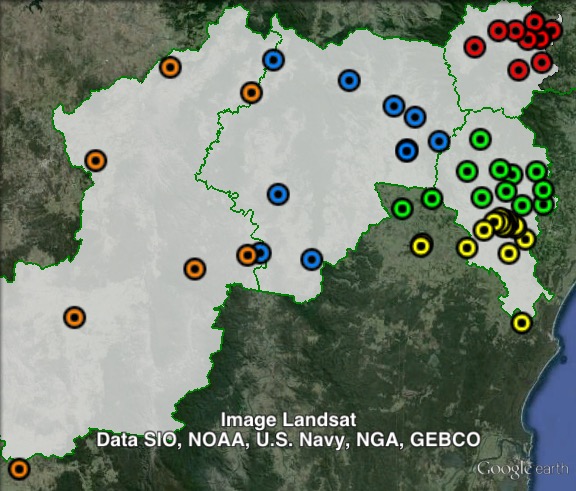
In my pre-election guide, I split up the polling places in Lismore into five sub-areas. A majority of the seat’s population lives in the City of Lismore, with the remainder of the seat split between Kyogle, Tenterfield and Tweed council areas. Lismore covers all of Lismore, Kyogle and Tenterfield councils, but only a small part of Tweed council, covering Murwillumbah.
I split these booths into five parts: Kyogle, Tenterfield, Tweed, Lismore South and Lismore North. Lismore South covers the town of Lismore, as well as a few rural booths to the south, while Lismore North covers rural booths to the north, including Nimbin, Bexhill and Goolmangar.
Prior to last weekend’s election, there was already a wide variation in the vote between these areas. The Nationals vote ranged from 48% in Lismore North to 66% in Lismore South. The Greens vote ranged from 15.7% in Lismore South to 35.9% in Lismore North. Labor’s vote peaked at 16% in Tweed.
Tenterfield was an unusual case, because a large majority of voters in that area had been part of the independent seat of Northern Tablelands in 2011, before being redistributed into Lismore.
| Voter group | NAT % | GRN % | ALP % | NATsw | GRNsw | ALPsw | Total | % of votes |
| Lismore South | 40.4 | 26.5 | 27.6 | -25.6 | 10.7 | 14.3 | 13,256 | 29.9 |
| Tweed | 38.7 | 28.5 | 28.0 | -14.4 | 4.4 | 11.9 | 5,867 | 13.2 |
| Lismore North | 27.5 | 48.7 | 19.5 | -20.6 | 12.8 | 7.7 | 4,328 | 9.8 |
| Kyogle | 46.0 | 24.3 | 24.2 | -18.2 | 6.4 | 11.1 | 3,300 | 7.4 |
| Tenterfield | 55.8 | 14.5 | 22.9 | 13.2 | 9.6 | 15.9 | 1,906 | 4.3 |
| Other votes | 48.4 | 20.6 | 25.6 | -10.8 | 4.1 | 13.7 | 15,719 | 35.4 |
Looking at this table, you can see widening trends. The Nationals vote went down everywhere except Tenterfield. The Nationals were hit particularly hard in the Lismore area. In Lismore South (covering the town of Lismore) the Nationals dropped 25.6%. Even in the Greens heartland of Lismore North, the Nationals vote dropped over 20%.
Overall there was a bigger swing to Labor than the Greens. Labor overtook the Greens in Lismore South, and also stayed ahead of the Greens in Tenterfield. In every region except Lismore North, the swing to the Greens was smaller than the swing to Labor. Despite this, the Greens gained positive swings in every area, ranging from 4.4% in Tweed to 12.8% in Lismore North.
What follows is the booth maps showing results. I’ve included seatwide maps for the Nationals, Greens and Labor, and zoomed-in maps for the town of Lismore. I’ve also included maps showing which out of Labor and the Greens had a higher vote in each booth, which is useful for understanding how the Greens stayed ahead of Labor. Labor outpolled the Greens in most booths in Kyogle and Tenterfield, along with booths around Murwillumbah. The town of Lismore was split down the middle, with the Greens polling higher in the north-west and Labor in the south-east.
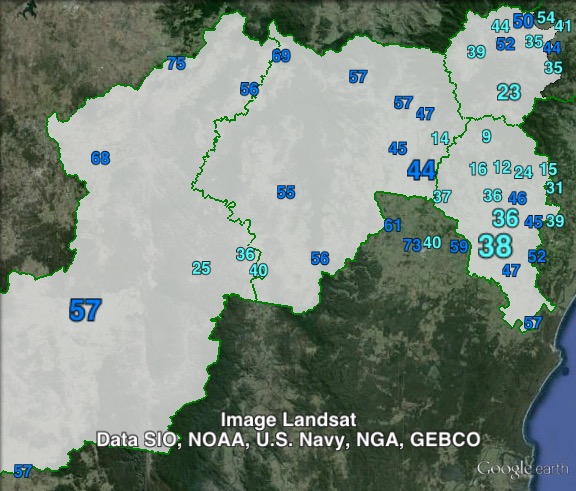
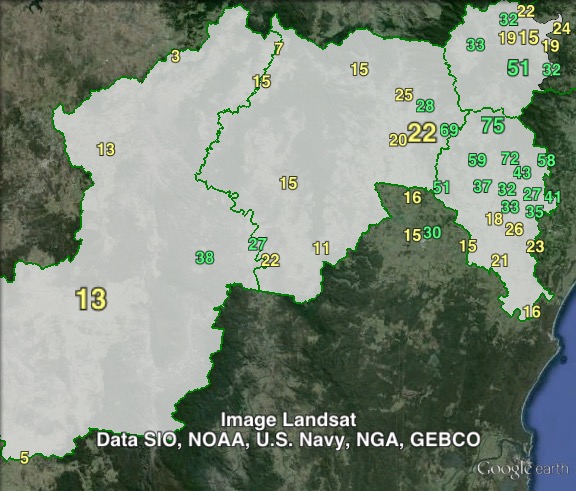
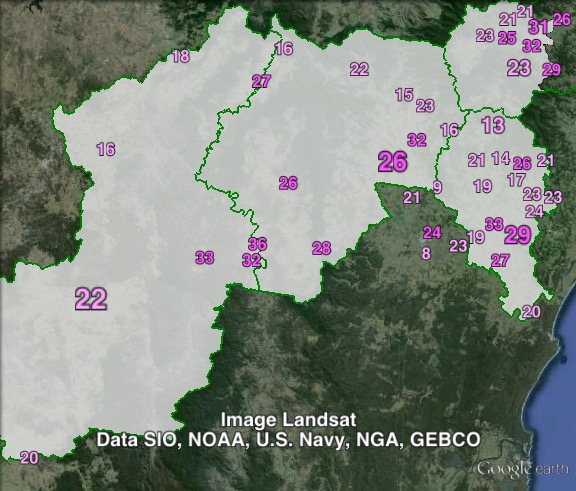
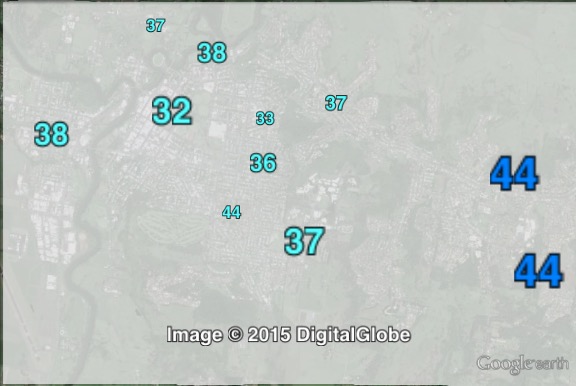
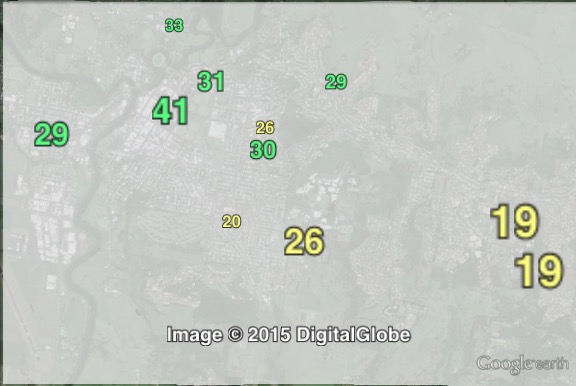
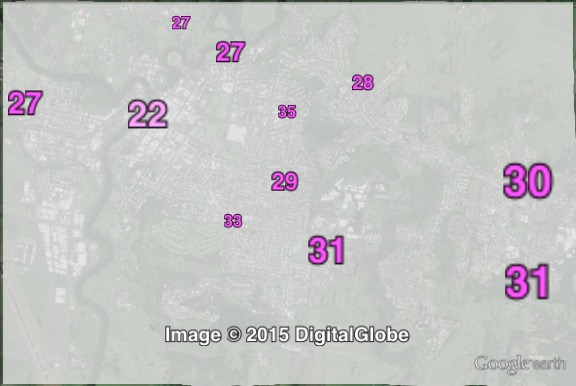
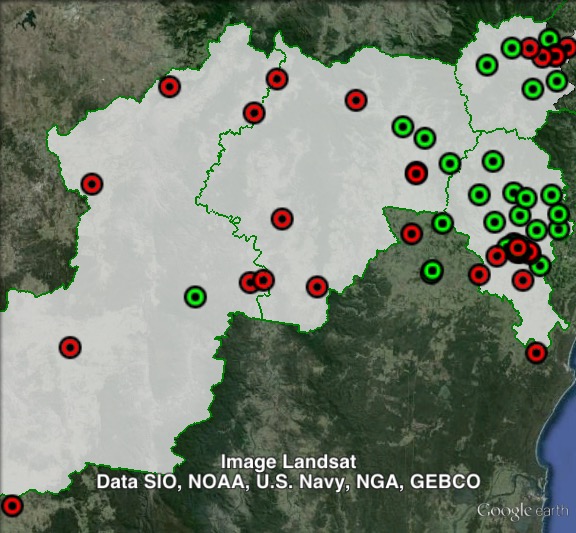
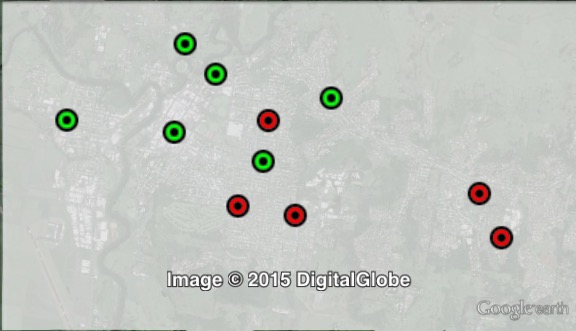



Hi Ben, you would probably be aware that in 2011 the Lismore primary vote to Greens was over 20%. ALP last election was a wipeout. So the smaller increased vote for Greens compared with Labor this time needs to be seen in a perspective.
Thanks for this excellent analysis. Bear in mind the fact that the ALP vote plummeted to only 13% in the last 2011 election due to corruption/Obeid etc. They have regained what they lost last time which was to be expected.
Trish and Sue – taking your comments in conjunction: the Greens vote increased much more than would have been predicted. I think it was their personaised presence at Bentley. I also think that it has been Labor’s pretence at being a “governing Party” (i. e. locking Labor into political correctness and a lack of the assertion from Opposition which we ordinary voters so yearn for and so legitimately expect) that led to Adam Guide being likely (despite ABC prediction) to win the Seat.
Bentley is in Clarence which was won easily by the Nationals.
Why was there so much activity in Lismore targeting George instead of Galuptis?
What was the real agenda?
Have you compared the Tenterfield and Deepwater booth results with the Northern Tablelands by-election in 2013, or the state election in 2011?
At Deepwater in 2013, the Nationals took 65% of the vote, the Greens 2% – Nationals vote in this election decreased by 9%, and Greens vote doubled to 4.6%. At Tenterfield in 2013, the Nationals took 55% of the vote, the Greens 5% – Nationals vote in this election increased by 2% to 57%, whereas the Greens vote more than doubled to 12.6%.
If the greens win this they’ll be very lucky………..
This election is like no other. It is another CSG election like the one run by Lismore City Council’s Country Labor Party. Reliable comparisons with past results are very difficult with so many voting on a single issue.
Based on primary votes and some info about preference flows, without a swing in the high 50s or more, the Greens are gone. Labor cannot bridge the gap to threaten either.
This election was not fought on a single issue in the Lismore electorate. To characterise it as a “anti-CSG vote” is to miss the point.
In Lismore, Ballina and Tweed electorates National Party sitting members suffered swings above 20% when they had margins of approximately 22%-24%.
This means that 1 in every 3 people who voted National in 2011 switched their vote away from the Nationals!
This reflects the focus in the campaigns in the three seats on a lack of local representation on a wide range of issues (and yes, CSG was a big part of this – but not all) including cuts to TAFE, the “poles and wires issue”, local health services etc etc etc.
Local communities had seen repeated behaviour by their local MPs that they did not like – and they sent them a stinging rebuke.
Don Page would have lost Ballina had he recontested the seat. The fact that he did not stand made the task somewhat easier but the fact that the Greens outpolled Labor should not be underestimated (despite Byron and surrounds being in the seat).
If Tamara Smith wins Ballina it will be the first time that the Greens have won a notionally Nationals seat.
Geoff Provest has held on in Tweed by the skin of his teeth. If the Greens vote had matched the 2011 result in Tweed then he would have lost and the seat would have fallen to Labor.
If Thomas George holds Lismore then it will only be because the electorate boundaries were changed to include the Tenterfield area, where neither the Labor nor Greens candidates were known. Yes – I know Thomas was not known either but he came from a known brand (Nats). If he holds the seat then it will only be by a pubic hair.
If Adam Guise wins Lismore then it will be the first time that the Greens have taken a seat from a sitting Nationals MP.
Even coming close in one or both of these seats represents a major sift in the political dynamic on the North Coast.
The Greens always claim victory even when they lose. Pay close attention to Ballina over the next four years and see why we do not want a minority Party representative to represent us.
Tweed was an easy win and Lismore will also be comfortable. The only concern has been dodgy preference deals.
If you can only win a seat with dodgy preference deals that most do not understand, you do not deserve to represent your community.
First past the post is the way to go!!!
Bi rob – You do not seem to understand how preferences work – in the lower house they are allocated by individuals not by parties – preferences work much better than first past the post but not as good as proportional representation to fairly represent community views.
On representation by a minority party – evidence is that they tend to work harder than the major parties and improve their support over time
I know exactly how they work.
Parties make dodgy deals and then spend copious amounts of money on advertising campaigns and how to vote material influencing how the majority of people who have no idea cast their votes.
The community does not understand preferential voting so it should be abolished.
Regarding minor parties, they tend to work harder and achieve nothing unless they hold a balance of power. This will not be the case in Ballina. I would hate to live there during the next few years.
You say the preference deals are “dodgy” – how so?
The evidence suggests that, regardless of how-to-votes, Greens and Labor voters are much more likely to preference each other’s candidate instead of preferencing a conservative candidate. So what is dodgy about recommending preferences that largely reflect what their voters support?
Do you think it’s dodgy for an independent who used to be a member of the Greens, and shares most of their policies, to recommend his voters preference them?
Big Rob, that is a dumb comment to make. Parties make recommendations on Preferences for the Lower House but the decision on preferences is solely at the discretion of the voter.
@Michael Mcnamara I think it is absolutely right to characterise it as PRIMARILY an anti-CSG vote. Of course it’s obvious that it wasn’t just a single issue that determined the result but let us be realistic.
You rightly point out that the Nats suffered large swings (Ballina didn’t have a sitting Nats MP by the way) but their margins were wildly inflated in any event, Tweed was a Labor held seat all through the Carr years after all. I will admit that the Greens did do well in Lismore and Ballina, but the Greens have always been particularly strong in the North Coast communities and you can see that even more prominently at the federal level in Richmond for example.
I completely disagree with your belief that the Greens still would have won if Page had stayed, you even said that local issues were central to the campaign. Surely then you realise that as a regional community the local member factor would have been instrumental in ensuring a Nat retain. Especially someone who had represented the area since 88 and whose family is well-known in the electorate.
I concur with Big Rob regarding Greens spin, they always like to claim they do well even when they go backwards. Just look at all that nonsense with Guise last week, demanding that George concede. It was as fanciful a prospect then as it is now. The sheer arrogance of the Greens is now plain, as they’ve been forced to eat their words admitting that ” a win is not looking likely”.
Finally I also repudiate your claim that this is “a major shift”, this has been a long-time in the coming, the Greens are very strong on the North Coast and there needed to be a major correction in the vote up there. Demographic change is rife and I suspect this is simply the culmination of that.
Sorry, I am a bit busy enjoying the Nationals win in Lismore to respond completely at this stage.
Lucky fewer than expected followed the flock. Baaaaaaaaa
Rob, I am a Coalition supporter and I am saying that it was a dumb comment.
Ok mate.
Anti-CSG sentiment was the major factor in these results. Other issues may have got attention during the campaign but it was CSG which created the public perception of dismal representation from these MPs.
It’s hard to know what would’ve happened in Ballina if Don Page had recontested. I suspect he would have scraped back in. He was a very savy politician and made a career out of differentiating himself from his party, albeit often arguably somewhat disingenuously.
Final distribution of preferences. FWIW, I’m with Hawkey_au: coalition supporter, but don’t think BB’s observations on preferences on point. After all, it was the coalition parties that introduced preferential voting in the first place, to avoid splitting the anti-Labor vote.
http://vtr.elections.nsw.gov.au/la-home.htm#la/lismore/dop/dop
@wreathy of Sydney – I did not say the Greens would have won if Don Page had stood. I said he would have lost (which was probably going a bit far). I should have said that Don Page may have lost.
I also talked about these results representing “a major shift in the political dynamic on the North Coast”. I stand by that comment.
In the seat of Lismore this is the second state election in a row that the Greens have been runners up. This time, they have not only consolidated the results from 2011 but have built on them to the point that the Nationals margin is now only 2.86% on the TCP. If this is not a major shift then I don’t know what is. Oh hang on … maybe winning Ballina with a 3.12% margin on the TCP might qualify.
Another way of looking at it is to compare Thomas George’s Primary vote in 2011 with 2015. In 2011 Thomas George’s Primary vote was just over 61%. In 2015 it was just over 42%.
This was also the trend in Tweed and Ballina (even allowing for Don Page’s personal following) in terms of National Party voters from 2011 to 2015.
I come back to the main point I made earlier that this means that 1 out of every 3 people who voted National in 2011 changed their vote in 2015. That is a pretty strong result by any measure and represents far more than a protest vote over one contentious issue.
That the Greens have outpolled Labor for two state elections in a row in Lismore electorate is also a significant change.
Taken together they justify my assertion that we have seen a major shift in the political dynamic here.
You guys are of course right. I always hear some of my friends on the right (yes I am also a Coalition supporter) demonise the preferential system at the moment where it is of great assistance to the ALP/Greens. Never do they stop to wonder what we would think of it if that position was reversed. After all it was not that long ago in which the Coalition was a great exploiter of the DLP and their preferences, arguably more helpful since they were former ALP voters giving preferences to the Libs. Let’s not forget that the Libs won several elections they otherwise wouldn’t have using this strategy.
@ Big Rob The only way that a “first past the post” system could work would be to have a two stage voting process with the first and second place getters from the first round going
head to head” in a second round vote.
P.S. Thomas George and Geoff Provest got elected because of preferences as well … so I would not complain about preferences too much if I was you.
Ben, dodgy because then Greens were attacking Labor through the campaign about taking coal seam gas company money but they still recommended preferencing each other even though their voters would not blindly follow.
Hawkeye, most voters and many ‘experts’ have no idea about preferencing.
Wreathy, it is expected many will return to the Nationals after seeing how poorly Ballina fairs under the Greens over the next four years. Money will be pumped into Lismore and Clarence now.
Hawkeye, I do not care who you support. Many up here voted like sheep not having a clue about what they were doing. I know this because I asked many people and many asked me to explain some of the issues.
Pyrmonter, it is irrelevant who introduced them The campaign to put the Nationals last was a desperate attempt by the Greens and Labor to win at any cost. Regarding making the decision for others, why do you think there is such an emphasis on having people at polling places handing out how to vote material. It is way too dodgy!
Big Rob, welcome to multi-party politics! You can dislike one party and still prefer them to another option!
That doesn’t mean it’s dodgy, or desperate, or make the voters who choose to preference “sheep”.
On the contrary, it seems like many progressive voters in Ballina used their preferences to full effect – voting for the candidate they genuinely preferred (be it Greens, Labor or Johnson) and then ensuring their vote flowed along to the candidate with a chance of winning. The same was almost true in Lismore.
If we had first-past-the-post it wouldn’t be as simple as the National getting elected – instead voters would be trying to decide which candidates had a chance of winning, and casting a tactical vote on that basis, and so various parties would be deciding whether to campaign or not, and trying to convince voters that they can win and others can’t. It may well have resulted in Greens voters switching to Labor due to polling suggesting Labor could win, and a Labor candidate winning despite being less preferred than National or Green.
FWIW The voters of Lismore, & especially Ballina have done themselves an enormous disservice. Should the govt decide these will be irredeemably lost, then money will be spent elsewhere. I’d expect that would definitely be the case in Ballina. Being a Green seat in a coalition parliament would be akin, to a ham sandwich , at a jewish picnic !!!.
Voters can be so stupid in voting against there own obvious self interest…..
History of such seats is that major parties in government spend money to try and get them back from minor parties – the amount of discretionary spending at an electorate level available to government is fairly small as a proportion of government spending so its real impacts are limited and the effect of this sort of behaviour is over stated.the point is Ballina is a competitive seat instead of s safe seat that the Nationals could take for granted – on balance they will probably be better off
@winediamond Your scenario is only one of many possible. Another possible scenario is that the re-elected Nationals members for Lismore and Tweed lift their game significantly in terms of representing their communities rather than representing the “team” and rebound at the next election, with a flow on effect to Ballina. Another scenario is that the state government targets Ballina in an effort to win it back at the next election.
Balmain had a Greens member through the life of the last parliament. He has been re-elected with a swing to him of over 6%, so voters do not necessarily see having a Greens rep during a conservative government as a bad thing.
Tweed electorate swung wildly over a number of years between Larry Anthony for the Nationals and Neville Newell for Labor (they also played tag in the federal electorate of Richmond for a time).
Being seen as a marginal seat can work wonders if the parties believe it is winnable.
As for the Coalition writing off Ballina as unwinnable in the future – Kris Beavis and the local Nationals members might have something to say about that, as might Thomas George and his supporters about Lismore.
My apologies for posting incorrect information. Larry Anthony never held the seat of Tweed. It was held by Neville Newell for Labor from 1999-2007 and Geoff Provest for the Nationals since then.
Agree with Doug (5.21pm), that’s what governments do if they can, but what about seats the they can’t win and in 2015, barely bothered to campaign in at all? I’m talking about the other two seats the Greens won down south (Newtown and Balmain)… If Balmain’s fate since 2011 is any guide, then the people of Ballina have just dealt themselves a dud hand indeed.
This is probably a broader issue than just the Lismore electorate but anyway … What do people think about the impact of optional preferential voting? Does it give a “true” picture of the wishes of the electorate? Do “exhausted ballots” favour the incumbent (or the leading candidate if a really big swing is on)?
coco bunter – if that is true what is the prognosis for genuine democracy? As noted above my view is that this factor is overrated in terms of what happens in the overall delivery of services – the differences are in the end fairly marginal – they remain at the end in the fairly minimal category where the government has any real discretion – sitting members for the government have a self interest in talking up what they achieve – all such accounts need to be taken with substantial dollops of salt
Michael, do you understand what first past the post means?
Ben, I was referring to the active campaign to put one Party last night. It is dodgy when two Parties work like that to win at any cost but do not form a coalition. You are also kidding yourself if you think most lodged tactical votes. The majority clearly had no idea. Most who blindly followed without understanding are sheep.
Wine, Lismore is fine. Nationals won. Ballina is gone though.
Doug, the money won’t be offered to Ballina until the next election. It certainly won’t be spent there before the next election because Greens will take credit for all spending. Basic stuff.
Michael, Ballina will return to the Nationals at the next election. Also, optional preferential voting favours the person with the most primary votes and was supposed to see a reduction in informal votes but they were up. A comparison cannot be made in relation to exhausted votes since preferences were not needed for the last few elections but I expect they will increase in electorates where they use optional preference voting.
Well what I find dodgy is when parties put up posters and run TV commercials at first glance designed to appear like official electoral commission information informing voters that they ‘only need to vote 1’. I find it a deliberate attempt to confuse voters who may have otherwise numbered additional preferences. Conceptually optional preferential is perfectly simple and gives voters maximum control over their vote, but it’s true that it hasn’t been explained well to voters. The NSWEC seems to do less and less voter education at every election and I don’t think this helps much.
I’m probably biased though, who knows…
Incidentally what did Don Page achieve for Ballina in his quarter-century as MP?
Coco Bunter
Thanks for the support. Yes. Balmain is a great example. The Greens have a trend of increasing their majority once ensconced. After all they can promise everything, say anything, & deliver nothing, no matter. Their constituency is hopelessly devoted, & idealistic. The evidence points to (elected) Greens MPs being impossible to dislodge in the near future.
cheers WD
Rob, again, that is Multi-Party Politics. Get used to it. And to suggest that the majority of people have no clue about how preferences work shows how much respect you have for other people.
I have also suggested that Federal Elections should be OPV because I believe OPV to be the most representative of the voting habits of people.
Big Rob – I’ve canvassed on the basis of “Put Labor Last” – essentially the same thing as you’re complainign about.
Personally, I tend to put the Socialist Alliance,Communists or whichever permutation of the nasty far Right – PHON, AIFF, Rise Up etc – is running last, but being in the inner city where there is rarely a shortage of motivated but hopeless candidates lets me do that).
The alternative to optional preferential voting (or “instant runoff” as some call it overseas), which I think the “least worst” system, is either the perversity of first past the post (winner can command a fraction of the overall electorate – need only be one vote more than the next most popular – classically seeing a “split in the anti-Labor vote) or full preferential, which results in the least disliked, rather than most preferred candidate winning.
Mike McNamara
I doubt the Nats took either of these seats “for granted”. If the govt has discretionary resources available they’d be better advised to spend them sandbagging marginal seats which will be under greater threat in 4 years. Obviously seats like Port Stephens, or Strathfield have more possibility (for the govt to retrieve), than Ballina.
WRT having a Green MP. See my post to Coco B. Are you serious , in saying there is an overall benefit ??.
IMO Lismore is gone next election, & probably Tweed too, unless Labor preference the Greens last. So i basically agree there has been a shift. However it has been obvious for quite some time.
Doug
Mate !! Open your eyes !!. Service delivery is small beer. What about infrastructure spending ?? Then think about the fed budget. Ask yourself if that (discretionary spending),will go to Labor, Or Coalition states ??. We are clearly talking many billions. Then you also have idiots like Dan Andrews Knocking back Fed money !!!.
As for question on “democracy”. It has always been thus.. Get with it mate.
Politicians talk up these infrastructure projects – most of them will get built regardless of the representation of the electorate – the big ones straddle more than one electorate. Governments want to be seen to be delivering overall. Over a ten year period I reckon that it would make very little difference who the representation was when it comes to the big projects. The only study I have seen suggests that marginal seats do better on the small grants programs nice little announceables.
@Michael Mcnamara Yes Page may have lost, I was merely pointing out that it was far more unlikely had he stood.
I agree it was a good result, however why I dispute the major shift is because it implies a precipitous change, this was anything but. I tried to explain that this has been a long time in the coming, the Greens have been strong on the North Coast for a long time and that rather than a major shift, it was more like a gradual bleeding of the Nat vote. Of course when examined with retrospect and over a cumulative timeline it could be characterised as a “major shift”.
Comparing George’s PV from 11 is meaningless, it is not an accurate barometer due to the lopsided result. Its an anomaly. Instead using the 07 result, his PV was 54%, so still a large drop but not as drastic as you suggested.
Yes you are right that 1 out of 3 Nats voters changed their position, but as I previously mentioned 11 is not the result to use, the margins for these seats were wildly inflated and there was bound to be a massive natural correction of that at this election. Furthermore the amount of people who changed their votes does not mean this was not a protest vote. The only way to determine that will be the next election to see if they can replicate the results.
My point is that yes the Greens did outpoll Labor for the second time, but that it was a long time in the coming, there was not a lot of percentage points separating the ALP and the Greens anyway.
This is why I say the results on the North Coast, whilst encouraging for the Greens, where not at all entirely unexpected and whilst perhaps constituting a major shift over a great period of time, when examining the demographic change etc its really like a small jump than that great big and unexpected leap.
Comments are closed.